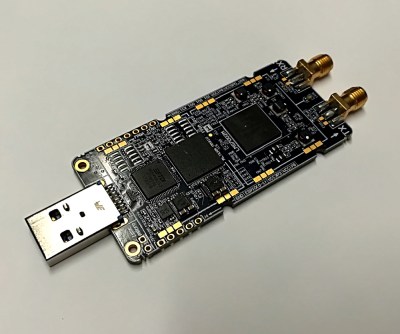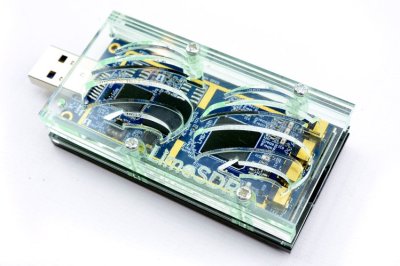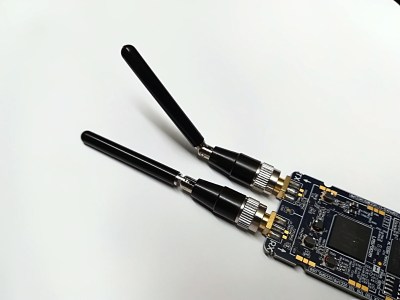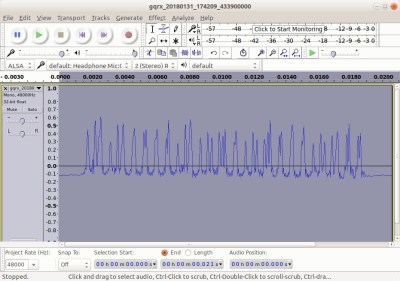
It’s fair to say that software-defined radio represents the most significant advance in affordable radio equipment that we have seen over the last decade or so. Moving signal processing from purpose-built analogue hardware into the realm of software has opened up so many exciting possibilities in terms of what can be done both with more traditional modes of radio communication and with newer ones made possible only by the new technology.
It’s also fair to say that radio enthusiasts seeking a high-performance SDR would also have to be prepared with a hefty bank balance, as some of the components required to deliver software defined radios have been rather expensive. Thus the budget end of the market has been the preserve of radios using the limited baseband bandwidth of an existing analogue interface such as a computer sound card, or of happy accidents in driver hacking such as the discovery that the cheap and now-ubiquitous RTL2832 chipset digital TV receivers could function as an SDR receiver. Transmitting has been, and still is, more expensive.

A new generation of budget SDRs, as typified by today’s subject the LimeSDR Mini, have brought down the price of transmitting. This is the latest addition to the LimeSDR range of products, an SDR transceiver and FPGA development board in a USB stick format that uses the same Lime Microsystems LMS7002M at its heart as the existing LimeSDR USB, but with a lower specification. Chief among the changes are that there is only one receive and one transmit channel to the USB’s two each, the bandwidth of 30.72 MHz is halved, and the lower-end frequency range jumps from 100 kHz to 10 MHz. The most interesting lower figure associated with the Mini though is its price, with the early birds snapping it up for $99 — half that of its predecessor. (It’s now available on Kickstarter for $139.)
We were lucky enough to be sent a pre-production LimeSDR Mini for review by the MyriadRF folks — in fact we were sent two of them, after the first one proved to have a hardware fault suspected to involve a solder joint issue. We feel their pain, after all who hasn’t had pre-production boards springing faults at inconvenient moments!

The board itself is a PCB about 33 mm x 70 mm (1,25 ” x 2.75 “), with a USB 3 plug at one end and a pair of SMA sockets at the other, one for receive and the other for transmit. The integrated circuits are all on the top of the board, and though they have included footprints screening cans, they are not populated. There is a single multicolor status LED between the SMA sockets. It’s worth mentioning that there will be a laser-cut plastic case for the board, which is probably worth getting as it feels somewhat vulnerable as it is. Along with as the board, they supplied a pair of little rubber duck antennas for the 870 MHz band.

It is evident that the LimeSDR Mini is an extremely capable board that in the hands of a real expert in SDR and FPGA programming could have the potential for great things. It is also evident that as your Hackaday scribe I am not an SDR extreme power user. Despite holding an amateur radio licence for over three decades I have been a relative late comer to the world of SDRs, and have not progressed beyond RTL-SDRs or simple devices using a PC soundcard for baseband. But it’s probable that while many SDR programming experts will indeed buy this board, the majority of its customers will be similarly newcomers to the art. Therefore this review will be biased towards the SDR non-guru, the long-time radio enthusiast considering the LimeSDR Mini as a first transceiver.
The first task with any SDR will always be to install whatever software is required on the host machine. Here that means a copy of the latest Ubuntu distribution, but Windows and MacOS machines are also supported. There is a handy page of instructions, which in the case of Ubuntu require you to add a PPA repository for the drivers, then install the Lime Suite software and the SoapySDR abstraction layer. It is this final package that makes the LimeSDR an interesting prospect, by offloading software compatibility onto the widely used abstraction layer they hope to avoid some of the pain seen with other products.
Testing it Out

Once the drivers have been installed, it is time to decide which software to run first. The Lime Suite GUI supplied with the driver packages will be the first port of call to test the board, but I am told that the version in the PPA at the time of writing with the Mini not having been released is written with the LimeSDR USB in mind and therefore I should use GQRX. In the case of Ubuntu this can be installed through the graphical software installer, but as luck would have it I already had it on my machine. Selecting “other” as my SDR and pasting driver=lime,soapy=0 as my device string soon had the familiar interface in front of me, and with a suitable antenna in no time I was listening to my local BBC Radio 4 FM transmitter.
![A simple FM transmitter, derived from this example by [Gyaresu].](https://hackadaycom.files.wordpress.com/2018/02/fm-tx-gnu-radio.jpg?w=400&h=281)
Two things are immediately apparent to an owner of an RTL-SDR, gone are the huge number of spurious peaks, and the noise floor is much lower. Reading GQRX with different front ends is an inexact and even slightly meaningless way to take measurements, but with all-automatic AGC, the RTL has a -60 dB noise floor and the LimeSDR has one below -90 dB. Just looking at the FM band, there are stations poking out of the noise that simply don’t exist with the RTL. It’s unsurprising that a piece of dedicated SDR hardware would outperform a $10 TV stick running a hack to make it an SDR, but if you are an RTL-SDR user then you will be pleasantly surprised by the Mini when you see it in action.

To have a board like the Mini and simply use it for GQRX is to waste so much of its potential. We are promised a library of tailor-made applications via Snappy Ubuntu Core, but this isn’t yet available pre-release. Your next stop would then probably follow ours with GNU Radio, and in particular its drag-and-drop GUI application GNU Radio Companion. This is nuts-and-bolts homebrew radio for the SDR age, just as analogue radio amateur homebrewers would solder their own radios while others bought shiny transceivers, so the SDR homebrewer can build their own devices using GNU Radio. It’s a package that’s beyond the scope of this review, but as an example when playing with the Mini it was fairly easy to cobble together a little GNU Radio receiver to pull in and extract the signals from a 433 MHz remote control transmitter we have in the house, and then regurgitate them through a 433MHz Baofeng antenna for the satisfying sight of a table lamp at the other end of the bench turning itself on. The Mini itself doesn’t intrude into this process beyond simply doing what it’s told once its communication with GNU Radio has been achieved, so experimenting further into the mechanics of decoding the bitstream itself became a matter of working through a set of tutorials and burning the midnight oil. The steep learning curve is amply offset by the satisfaction of playing with the instant gratification of radio building blocks without the pain of reworking any intricate soldering.
In transmission terms the maximum 100 mW output power is fairly modest for anyone used to amateur radio. But given that many applications for this board will involve the likes of sniffing for and responding to more local devices rather than seeking contacts from other continents this is something likely only to trouble radio amateurs without the wherewithal for a power amplifier. The twin antenna connectors will be somewhat annoying if you are used to a single one on a simplex transceiver, unless you are transmitting and receiving on different frequencies, of course.
A review of an SDR over a short period can not hope to cover all its many capabilities, so this one has been an impression of the Mini as a platform for experimentation and learning about how to use an SDR transceiver. But in just the time that it has been on the bench here, the Mini has opened a significant new vista over an RTL-SDR, and given a few months in which to play with GNU Radio will I am sure provide both some useful radio applications and a seriously interesting learning process.
Previous SDRs at the budget end of the market such as the HackRF have all remained somewhat expensive purchases, ones a typical radio amateur might have had difficulty concealing from their partner in the family accounts. With a price point that is almost edging into the realm of an impulse purchase, the Mini has the potential to become an SDR transceiver for everyone. If you have been holding back because of the price, maybe it’s time you gave it a look.
